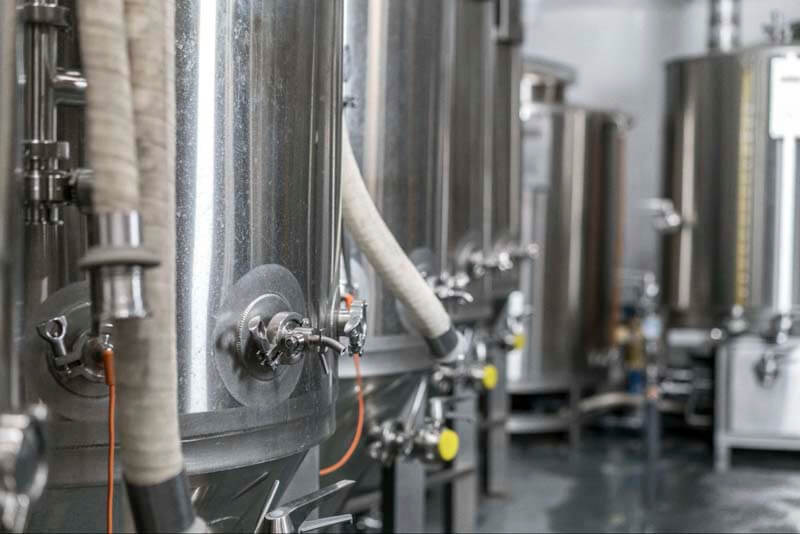6 Ways to Maintain a Clean and Sanitized Brewery

September 12, 2022

Fact: Clean and sanitized equipment produces better beer. Hygiene and sanitation are so essential to a brewery's success that a majority of brewers simply spend the first several years of their careers studying how to clean the brewery, according to Craft Brewing Business.
In fact, there’s a common belief in the industry that brewing is ninety percent cleaning and ten percent actually brewing.
Cleanliness and sanitation are so important that the U.S. FDA requires all breweries to maintain an active GMP (Good Manufacturing Practices) program.
For instance, GMP standards require that breweries sanitize all their equipment, including hydrometers, tanks, hoses, kegs, drains, and floors every day.
Since proper cleaning and sanitizing processes help produce the best beer possible, let’s be sure that your brewery understands the six best practices we’ve outlined below.
Afterall, everyone is happier with better beer!
What We’ll Cover in This Piece:
Why Cleaning and Sanitizing Your Equipment Produces the Best Beer
Brewing is a capital ‘S’ Science. And while some microorganisms benefit beer, others damage it, affecting the quality and flavor.
As you probably already know, basically every piece of equipment that touches your beer needs to be both cleaned and sanitized.
But there are a few crucial practices that every brewery should be following.
The 6 Best Ways to Clean and Sanitize Your Brewery
Safety First With Sealed Floors
A brewery cannot exist without occasionally spilling beer on the floor. While these spills themselves are not dangerous, they can have long-term issues without the proper floor sealants.
For example, if you have a spill on an unsealed floor, like concrete, you’ll never be able to remove the spilled liquid. This moisture produces the ideal conditions for the growth of bacteria and mold.
So, since breweries, by nature, are wet environments, solid sealants like epoxy can help lock out that moisture. An additional safety precaution on top of sealing your floor is to choose the best grip form to prevent staff from slipping and sliding!

Keep Your Hoses Clean and Dry
Maintaining the quality of all hoses is crucial.
If brewery hoses are not properly cleaned, they can become the ideal habitat for a variety of bacteria. Best practices when cleaning your hoses include:
- Hose bumpers are a worthy investment to help ensure the opening of your hose isn’t touching the ground
- Utilize the mash tun to clean the outside of your hoses
- Hang your hoses to air dry as an effective way to prevent damage
Use the Proper Sanitizers
Like we stated previously, a clean and sanitized brewery produces better beer. That’s why it is crucial to sanitize all of your brewing equipment.
It is pretty common for brewers to use a no-rinse acid sanitizer, like Reflex, which is ideal for use on stainless steel and plastic in beverage-processing facilities.
“It’s excellent for time management, allowing you to do your acid cycle and sanitizer cycle at the same time,” says Dustin Jeffers, Solutions Consultant for Next Glass who previously brewed at Saltwater Brewery and 3 Sons Brewing Co. “I’ve tested this at multiple breweries with ATP monitoring and we never noticed a difference between separate acid and sanitizer cycles versus the combined acid and sanitizer found in Reflex.”
Additionally, according to ATPGroup, “Reflex was developed specifically for CIP and COP pipeline, silo, tank, and equipment cleaning and sanitizing and exhibits excellent bactericidal and fungicidal activity against a wide range of microorganisms in cold or warm water, preventing the formation of beerstone, milkstone, and limescale deposits”
Don’t Forget to Clean Your Drains (And Install a Top-Notch Drainage System)
Floor drains are essential to any brewery setup, but they’re also ripe for encouraging bacteria to grow. Just think about it: What goes down your brewery floor drains everyday? Lots of different liquids, right?
Plus, a large amount of water.
Depending on their size, breweries often use up to twelve gallons of water just to brew one gallon of beer. Some larger breweries drain 200–300 gallons of liquid every day.
That’s a lot of moisture just calling out for sanitation problems.
The approach here is two-fold: Don’t forget to clean your drains, but more importantly, invest in a top-notch drainage system designed to prevent bacteria build-up.
For instance, a well-thought-out plan for cleaning your drainage system or just investing in a top-notch one will be hugely beneficial to keeping your brewery clean.
Label Cleaning Products
To ensure all parts of your brewery remain clean and sanitized, assign specific cleaning tools such as buckets, brooms, and mops to certain parts of your facility. Otherwise, you risk cross-contamination.
Think of it this way: Commercial kitchens often color code their cutting boards based on what is being prepped on them—blue for fish, red for meat, and green for veggies. This practice helps reduce the risk of cross-contamination.
Likewise in a brewery, cross-contamination can be avoided by clearly labeling and color coding the different cleaning tools.

Finally, Review Your Cleaning Procedures Every Six Months
You can maintain control of the brewery's hygiene by periodically reviewing and analyzing your procedures.
Take the time to periodically check your cleaning and sanitizing processes to evaluate what can be altered or improved.
A good litmus test: Tune into what your customers are saying. What are their opinions of the beer's flavor? Has it been favorable or unfavorable?
If your customers find off flavors in your beers, investigate whether your cleaning procedures are to blame.
In the world of a brewer, cleaning up is half the work, so staying on top of your cleaning procedures is crucial. You should be able to stay problem-free as long as you keep a running record of everything and follow a regular cleaning plan and routine.
Improve Your Brewery Production
Ollie is the platform built by brewers, for brewers™. Increase brewery productivity and sell more beer. Everything you need in one place.
